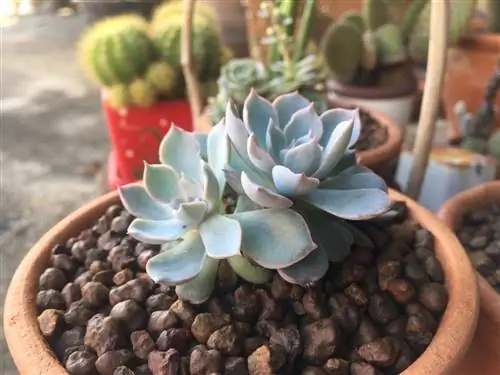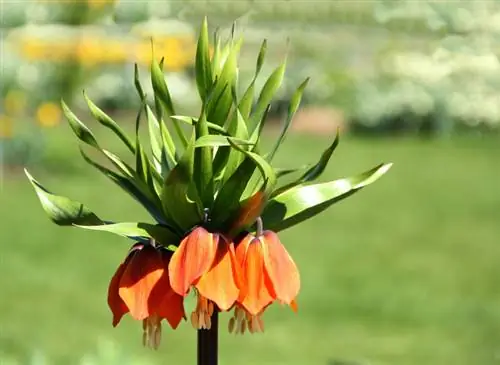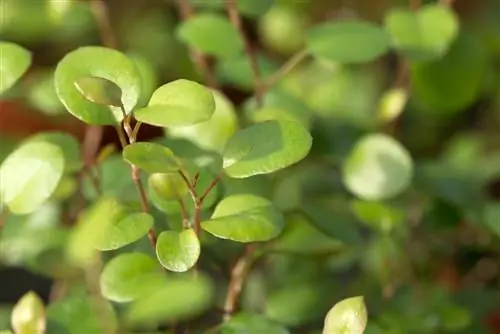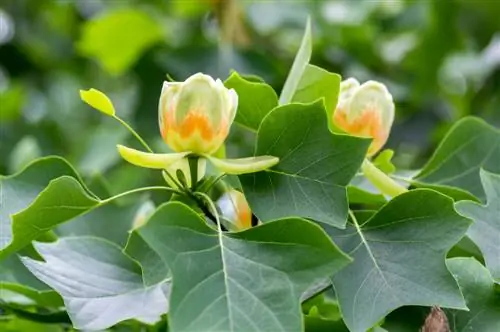- Author admin [email protected].
- Public 2023-12-16 16:46.
- Last modified 2025-06-01 06:02.
Echeverias, like cacti, are not only for fans of exotic houseplants, but also for everyone who is rarely at home and/or who lacks a green thumb. Because as succulents, the attractive window sill ornaments are largely self-sufficient.
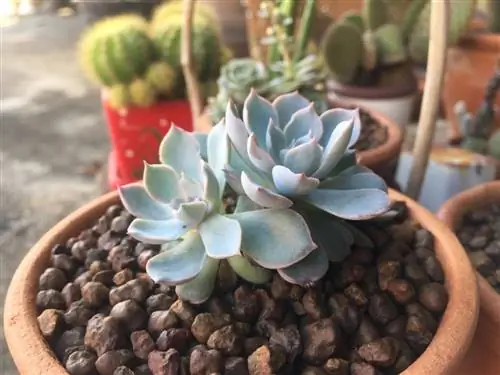
How do I care for an Echeveria plant?
Echeverias are easy-care succulents with attractive rosette-shaped leaves. They prefer bright, sunny locations, require little water and thrive in permeable, mineral substrate. Overwintering in cooler temperatures promotes flowering in spring.
Profile / Species
Garden centers usually sell hybrid forms of different types of echeverias. In general, however, they are categorized according to the approximately 150 species belonging to the genus Echeveria. The most popular and most frequently encountered species and cultivars are as follows:
Echeveria agavoides
This species is very representative of its genus: With its 10 cm long, triangular, tapering leaves, it forms a neat, neatly structured rosette about 12 centimeters in diameter. It remains quite low at around 10-12 centimeters high. In particularly sunny locations, the edges of the bright, fresh green leaves turn reddish.
The flowers appear between March and April in bell-shaped, orange-red to pink flower clusters on tall stems.
Well-known cultivars of this species include, for example, the varieties E. a. Multifida with numerous, lush, amber-colored and brick-red-edged leaves and E. a. Prolifera with orange leaf edges.
Echeveria harmsii
The E. harmsii stands out from other Echeveria species due to its rather loose, not so compact growth. Its leaves have a slender, inverted ovoid shape with a moderately pointed end and form an airy rosette when spaced loosely apart. They are also covered in silvery hair and therefore appear fluffy.
E. harmsii has a shrubby habit with a slender trunk and grows to a height of around 30 to 50 cm.
In May to June, tall-stemmed inflorescences about 15 cm high with scarlet-red, yellow-tipped flowers develop, which are not arranged in racemes like most echeverias, but are solitary.
Echeveria elegans
The E. elegans has a very stocky, stemless habit with a compact rosette of leaves about 10 centimeters in diameter. The individual leaves are only 2 to 5 cm long and form an attractive structure thanks to their spatula-like edge with a long tip. The leaves are also relatively flat compared to those of other Echeveria species and are staggered close together in the center of the rosette. Their color is a cool, gray-blue green that shimmers slightly due to the short, white hair. The tips stand out contrastingly in burgundy red.
In summer, the E elegans produces racemose flowers in pink or yellow on stems about 30 cm long.
Breeds
There are also countless individual cultivars available, especially in online stores, some with ornate names such as E. Afterglow, whose leaves turn powdery violet, or E. Arlie Wright, whose leaf edges are curly and pinkish-red.
Profile / Flowers
In spring to early summer, between March and June, the echeveria shows quite showy, pretty inflorescences that grow on a long stalk from the side leaf axils. The stems can be up to 3 cm long, so that the flowers are enthroned high above the low rosette of leaves. At the end of the stem, several flowers are usually formed in clusters, usually in reddish to pink tones, sometimes orange-yellow to greenish colors. The flower clusters hang over like a bell.
Flower characteristics in keywords:
- Flowering period from early spring to early summer
- raceous inflorescences on tall stems
- Colors vary from red to orange, yellow and green
Profile / Poisonous?
Echeverias are slightly poisonous, although this also depends on the species. However, the toxin content is low, so they do not pose any serious danger. To be on the safe side, if you have small children or pets living with you, you should take certain precautions. Place the Echeveria in a high place that is out of reach of curious roommates.
The substances contained in the plant sap can cause skin irritation, but there is no life-threatening risk of poisoning. When removing old inflorescences, work with gloves if necessary, especially if you are generally sensitive to skin irritation.
Profile / Hardy weather
Echeverias are of course not winter hardy. None of the different species is frost hardy - so long-term planting outdoors is not possible. The wintering quarters in the house must also be frost-free, even if the plant likes it cooler there.
Temporary planting in summer is of course possible and, given the small, compact size of the plant, it is not particularly time-consuming. Sunny rock garden designs around the terrace in particular can be attractively enriched with echeverias. Wait until May to plant the ice saints. As soon as the first night frosts are announced in autumn, dig up the echeverias again and bring them into the house.
To remember:
- Echeverias not hardy
- Always protect from frost
- Can be planted in summer between Ice Saints and the first autumn frosts
Profile / Origin
The Echeveria is primarily native to Mexico, where it inhabits dry rocky areas between 500 and 3000 meters high. However, their distribution area also extends north and south - some species can also be found in the south of the USA, especially in Texas, or in northern South America, for example in Peru. In its original habitat with little rain, it has adapted to the circumstances with its fleshy, water-storing leaves.
This of course has advantages for the local houseplant culture, as you don't have to worry about them much. An ideal greenery for everyone who can't/doesn't want to spend a lot of time caring for houseplants in everyday life.
To remember:
- comes from dry rocky areas especially in Mexico, southern USA and northern South America
- is therefore very frugal, hardly needs any attention
Profile / Growth
Echeverias belong to the thick-leaved plant family and are generally evergreen succulents. Typical of its appearance is its low, compressed, rosette-like growth, which makes it appear as if it is nestled on the ground. As a rule, the Echeveria only remains 10 to 15 cm high. Some species also grow as small shrubs.
Profile / Leaves
The leaves of Echeveria are the most important for ornamental gardening purposes. They are extremely beautiful both as individual specimens and together in the rosette arrangement. About 20 of them stand together above the squat shoot axis and have a mostly triangular to inverted egg-shaped shape that tapers to a point at the front. Overall they form a 7 to 10 cm wide rosette.
Since the leaves of the plant serve as a water reservoir, they have a thick, fleshy consistency that is typical of leaf succulents. They have a high water-holding capacity and allow the Echeveria to survive long dry periods without complaint. However, the succulent structure of the leaves also makes them susceptible to breaking. So always handle the leaf rosette as carefully as possible. The leaves of some species have downy pubescence.
In terms of color, the leaves usually appear in a dull, light green, sometimes in grayish-bluish green tones or in purple-tinged red tones. In the green varieties, the leaf edges and tips often have a slightly reddish color.
Leaf properties at a glance:
- mostly triangular to inverted egg-shaped shape
- together form a 7-10 cm wide leaf rosette
- thick fleshy consistency, slightly fragile
- high water storage capacity
- light green to bluish, grayish and reddish colors
Plants / Location
Echeverias are used to a lot of sun in their original habitat. Therefore, give your plant the brightest possible location in your room at home. The Echeveria has no objection to constant sunlight and heat. A spot by a large, south-facing window is ideal for them. You can also put it outside over the summer, but it should be protected from rain.
In terms of temperature, the Echeveria likes it - no surprise - warm. You are on the safe side with year-round cultivation in a warm room. But she likes it a little cooler over the winter. Around 15°C is better here, especially if you value flowering the following spring.
Location requirements at a glance:
- warm and sunny
- dry - if you are growing outside for a while in the summer, keep it protected from the rain
- slightly cooler in winter (cold stimulus for flower formation)
Plants / Soil
Echeverias require a permeable, mineral substrate with moderate nutrient content. Cactus soil (€12.00 on Amazon) from specialist retailers is a good choice. If you mix it yourself, use some compost soil, coarse sand and, if necessary, some volcanic rock.
Planting / Propagating
Daughter rosettes
Echeverias form a few daughter rosettes in the pot over time and thus multiply by themselves. You can simply dig up the daughter rosettes and put them in new pots.
Cuttings
If the Echeveria does not have any daughter rosettes to offer at the time you want to get a cutting for your plant collection or give it away to someone else, there is also the option of propagating from cuttings. To do this, pluck a leaf from the rosette and place it in a planter with a peaty, sandy substrate. Place the growing pot warm and bright.
Seed cultivation
You can also grow echeverias from seeds. However, some varieties do not produce fertile seeds, so if you want to be on the safe side, you should use seeds from specialist retailers. Place the seeds in a sandy growing substrate that is kept moderately moist. They germinate best at around 18°C.
Care / Watering
When it comes to water, Echeveria is a true ascetic. It requires very little watering, which makes it ideal for people who are on the go a lot. Basically, you only need to water sporadically - and only when the substrate is completely dry. As with many other thirstless plants, the rule of thumb applies to Echeveria: too little is always better than too much. If it gets too much water, the Echeveria will indicate this quite clearly by fading its leaves.
The succulent plant doesn't like its leaves getting a cold shower - so only water on the soil. Otherwise, rot can also occur in the leaf rosette.
In winter you hardly need to water at all.
Casting practice at a glance:
- Watering very little
- Only pour onto the substrate, not into the leaf rosette
- Quit watering in winter
Care / Fertilization
The Echeveria doesn't actually need to be fertilized. However, if it has been in a pot for more than 2 years, you can give it some nutritional supplements over the summer months. To do this, use gentle fertilizer, either cactus fertilizer from specialist retailers or organic fertilizer from your own household and garden such as coffee grounds, compost or nettle manure. The fertilizer application frequency is roughly based on the watering - i.e. only very occasionally. From September you should stop adding fertilizer.
To remember:
- It is advisable to add some fertilizer to a pot from the second year onwards
- Use gentle cactus fertilizer, compost, coffee grounds or nettle manure
- Only during the summer months, parallel to the watering intervals
Care / Repotting
If you want to do something good for your Echeveria, you should treat it to a new substrate every two years. The plant rarely really needs more space; the used substrate is more likely the reason for moving the pot. In spring, place the Echeveria in a new mixture of compost and sand.
Care / Cutting
The Echeveria itself does not need to be cut. Their compact rosette growth doesn't even tempt you to do so. However, what you can do to care for the plant is to remove old and dried parts. This includes dead inflorescences and worn-out leaves. But you don't need to cut these with a cutting tool. It's better to just pluck them out.
To remember:
- Echeveria doesn't need topiary
- Only remove old, dried plant parts, preferably by plucking them out
Care / Illnesses
The Echeveria is pleasantly resistant to disease, which increases its appeal for less dedicated houseplant enthusiasts. The most likely thing to harm it is too much water, which can lead to mold and rot.
Care / Pests
Echeveria is also not very susceptible to pests. During the flowering period, aphids may appear on the inflorescences. You can recognize the small reddish to blackish or greenish insects primarily by the honeydew that they secrete by sucking the plant sap and sticks to the leaves and windowsills.
The best way to combat an aphid infestation is to start by mechanically spraying the plant. If the infestation is more advanced, you can use neem oil-based preparations or a mixture of water and potassium soap. This suffocates the pests.
Alternatively, you can also use plant protection sticks. You simply need to stick these into the soil so that they gradually release their active ingredient, which is toxic to the lice, into the plant.
Frequently asked questions
Can you eat Echeveria?
Of course you shouldn't eat an Echeveria given its slight toxicity. However, there is no real reason to worry about this either. Even if parts of the plant are consumed, there will only be irritation of the mucous membranes, but there is no risk of fatal poisoning. The required consumption dose would hardly be eaten.
My Echeveria has black spots
Black spots indicate overwatering or fungal infection.
Tip
To protect the Echeveria from leaf rot, it is recommended to cover the top of the substrate with a layer of sand. This also underlines their exotic character.

